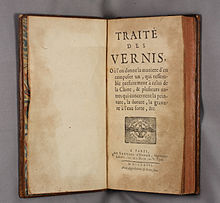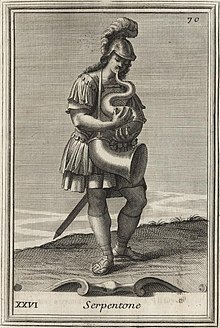|
Filippo Bonanni
Filippo Bonanni; S.J. or Buonanni (7 January 1638 – 30 March 1723) was an Italian Jesuit scholar. His many works included treatises on fields ranging from anatomy to music. He created the earliest practical illustrated guide for shell collectors in 1681, for which he is considered a founder of conchology.[2] He also published a study of lacquer that has been of lasting value since his death.[3] Life   Bonanni was born in Rome in 1638, and entered the Society of Jesus in 1654, when he was still 17 years old. After his novitiate, in 1656 he was sent to study at the Society's noted Roman College. There he became a pupil of the German scientist, Athanasius Kircher. While a student there, he undertook the manufacturing of microscopic lenses. He used his lenses to create his own microscope and to develop scientific studies of a number of specimens. He also became a skilled copper plate engraver.[3] From Rome, Bonanni was sent to teach in the Jesuit Colleges of Orvieto and Ancona.[3] Upon Kircher's resignation of the post of Professor of Mathematics at the Roman College, Bonanni was chosen to succeed him. In 1698, years after Kircher's death (1680), Bonanni was appointed curator of the well-known collection installed in the Roman College, which had been under Kircher's care up to that point.[3][4] The Roman College asked Buonanni to take on the project of publishing a catalogue of Kircher's museum. After ten years work, he published the Musaeum Kircherianum (1709), a large folio volume that listed all of the objects in the collection and illustrated many of them.[3][2] The catalogue is divided into twelve sections (Classes) concerning the various categories of objects. The antiquities occupy the first five sections and are collected in ethnographic criteria. Bonanni followed Aristotle in believing in theories of spontaneous generation.[2] In critiquing the experimental work of Francesco Redi, Bonanni defended the Aristotelian view.[5] Though he raised important questions—such as whether viewers through a microscope tended to see what they expected, rather than what was there—later writers tended to discount Bonanni as support for Aristotelianism waned.[6] Nonetheless, in early writing about the nature and origins of fossils, Bonanni admitted doubts about whether theories of transport could account for the numbers and distribution of fossils. He later speculated that fossils could be divided into two groups—the remains of organisms, and the "products of natural powers." Such interpretations were consistent with the new and challenging idea that the earth must have undergone "extraordinary alterations" to explain the diversity of types and locations of fossils.[6] ConchologyBonanni created the earliest practical illustrated guide for shell collectors, Recreatione dell'occhio e della mente (1681). The two-volume guide was the first treatise devoted entirely to molluscs and included numerous engravings. Bonanni's work is significant for his careful attempts to precisely describe shell morphology. Due to the printing and engraving process, the spirals shown on the shells were reversed from dextral to sinistral, a mirror image problem that later books avoided. Zoological taxonomies of the time were based on visual characteristics, and Bonanni paid special attention to both form and color, and showed details (sometimes fanciful) of the creatures inside the shells. Although his work predated the adoption of Linnaeus' system of binomial nomenclature (genus + species), Bonanni laid the foundation for the new discipline of conchology.[2] Several later Linnaean names were based on Bonanni's work, including the name of the class Bivalvia, which he introduced.[7] LacquerAmong other topics, Bonanni wrote of the ingredients craftsmen in China used to make the lacquer they used on porcelain, a popular import item for Europe at the time. Like other researchers of the day, he went on to experiment with various recipes to recreate the lacquer used on porcelain and furniture. In 1720, Bonanni published his studies in Trattato sopra la vernice detta communemente cinese (1720), or Treatise on the Varnish commonly called Chinese. This work was republished repeatedly over the next century in several languages, and was re-issued in 1994 in its original Italian version.[3] Scientific work Bonanni made excellent observations, which are embodied in several works:
Bonanni was a shell collector and was the author of the first book devoted solely to seashells, published in Rome in 1681. Several later Linnaean names were based on his illustrations.
Using a three lens microscope, in this work published in 1691 Bonanni tried to show that spontaneous generation was possible in animals "without blood and a heart", in contradiction of Francesco Redi’s experimental work. The compilation of knowledge and quality of the illustrations made this an important work.
A two-volume study started in 1696 and completed in 1702 of the coins issued by the papacy over the centuries.
The catalogue of Kircher's collection (1709).
His work on lacquer, published 1720.
Issued first time in 1722, and immediately reprinted in 1723, this is a splendid collection of 152 engravings of musical instruments from around the world.[8] Publications
References
Bibliography
External links
|
||||||||||||||||||||||||||||||||||

